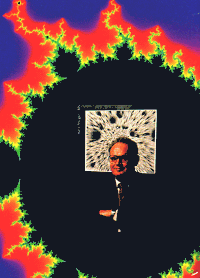Not only are cauliflowers, brains and landscapes fractal
- the entire universe is too
Colour images are more problematic: there is a far wider range of colours
than there are shades of grey. As a result, colour image compression algorithms
so far developed either lose some information from the original or do not
compress very tightly. In the late 1980s, however, British mathematician
Mike
Barnsley discovered fractals to be particularly good at capturing the
essence of images.
Using maths to store pin-sharp pictures
|
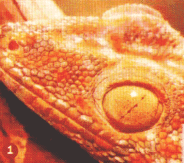 |
These pictures of a gecko illustrate the advantages of "fractal"
compression. 1: full size. 2: close-up of a conventional bitmap. 3: the more
realistic close-up of a fractal image |
| Pictures stored on a computer are made up of thousands of
individual dots, the colour of each defined by up to four data channels.
As a result, storing a picture can take several megabytes. All image compression
algorithms work by finding patterns which can be stored in a smaller space.
For example, JPEG
pictures are divided into areas containing different patterns. Fractal
compression looks for fractal patterns, and stores only the mathematical
description of each fractal, saving huge amounts of space. |
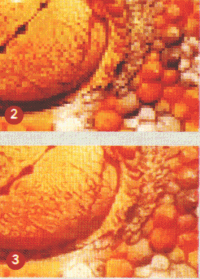 |
As mathematical recipes for fractals use far less memory than the original
data, the images can be compressed by huge amounts - a factor of 100 or more.
Better still, although working out the right fractals to compress a particular
image might take a while, decompressing the image would be fast, as fractals
are just mathematical formulae - bread-and-butter
work to any computer. Thus no super-sophisticated hard- ware or software
would be needed to "unpack" a fractal image.
But best of all, Barnsley saw that fractally stored images have an almost
magical quality:just like the famous Mandelbrot Set, they can be magnified
closely without losing detail; the formulae just go on generating image detail.
Users of Microsoft's well-known Encarta CD-ROM encyclopaedia have
Barnsley to thank for the compression of its 7000 images, reducing the CDs
required from ten to two.
Fractal image compression is becoming commonplace. The Scottish Prisons Service
is using it to store mugshots of thousands of prisoners in a computer database.
If a prisoner escapes, the resulting fractal image is small enough to be
sent to police forces via the ordinary telephone network and stored on a
laptop computer. Meanwhile the Queen Mother Library of Aberdeen University
recently used fractal compression to shrink a collection of 44,000 historic
photographs down on to a single CD- ROM - a somewhat handier format than
the five tonnes of magic lantern glass plates on which the images were originally
stored.
Fractals may soon be used to expand the world's supply of oil and minerals.
Geologists have found them to be a handy way of determining the extent to
which layers of rock are broken up - a task which may prove invaluable for
finding buried riches. At the heart of this technique is a feature again
highlighted by Benoit Mandelbrot: fractals' curious "dimensionality". The
term may be unfamiliar, but the concept isn't: a point is an object with
no dimensions, while a line has one dimension, an area has two, and a solid
has three. A fractal, in contrast, is an object occupying a strange hinterland
between these whole-number dimensions. The greater the fractal dimension,
the greater the "jaggedness" and convolution. Mandelbrot created a formula
for calculating the dimensionality of a given fractal, along with some intriguing
examples of its use. For example, the "jaggedness" of a coastline can be
summed up by its fractal dimension: for the coast of Britain, it is around
1.25, while for the much smoother edges of South Africa it is around 1.0.
Geologists are now applying this fractal dimension to features such as faulting
and veining, which have long served as clues to the existence of hidden deposits.
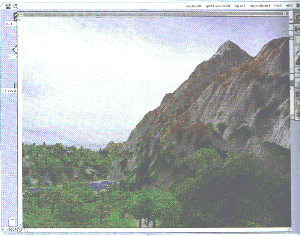 |
How fractal landscapes repeat patterns of the natural
world
Coastlines are jagged, their rocks are similarly jagged, and so on, all the
way down to a grain of sand - and the same is true of all other natural
phenomena. So the natural world is fractal. Because of this, programs using
fractal mathematics can create extraordinarily realistic natural images;
we produced the one above with a software package called vista Pro. A comparison
with a scene from the "real world" (right) shows how close to reality fractally
generated images are becoming |
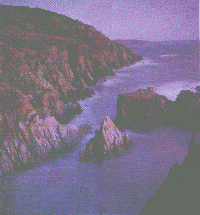 |
For example, a high level of quartz veins in drill cores have been linked
to good quality gold seams. By counting the varying thickness of veins in
such cores, David Sanderson and colleagues at Southampton University have
been able to work out the fractal dimension of the veining - and link it
to the likely concentration of gold in the area. They discovered that the
lower the fractal dimension. the better the gold deposit.The explanation,they
suspect, is that the thicker veining implied by the low fractal dimension
has larger gaps through which water can flow. More water means a greater
chance of tiny gold particles being carried in and trapped.
If this is true, measuring the fractal dimension of core samples may help
exploration companies find other resources; the Southampton University team
is currently using the same techniques in the search for tin and tungsten.
On a grander scale, fractal dimensions may also help seismologists give more
reliable estimates of earthquake risks. In the 1930s, seismologists Beno
Gutenberg and Charles Richter showed that the frequency of earthquakes follows
a law: roughly speaking. big earthquakes are rare. medium ones fairly common,
and feeble ones happen all the time. Earthquakes follow a "fractal" law and.
just as the harder you look at the Mandelbrot Set the more detail you find,
so the more sensitive your detection equipment the more earthquakes you will
find.
By analysing earthquake data, scientists at the US Geological Survey have
worked out the fractal dimension for quakes in the Los Angeles area. Publishing
their results recently in Science, they concluded that there should be around
six powerful quakes of magnitude 6.6 about every 250 to 300 years. The bad
news for LA is that historical records suggest the area is behind on its
quota... Fractals are even finding applications in deep space.
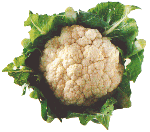 |
Vegetable Head
A cauliflower and a brain look remarkably alike- despite the fact that they
develop in completely different environments and are made from different
proteins.The reason? A fractal process underlies the growth of both |
Nature grows
fractal
You can find a fractal in your kitchen (or in your head). Take a close look
at a cauliflower - perhaps slice it in two - and you will see a branching
structure: each floret is like a miniature cauliflower - and if you look
even more closely each floret is made up of still tinier replicas of itself.
Similar self-repeating structures are found in the membrane of the brain
- and in this case, how fractal the structure is appears to be linked to
brain malfunctions like schizophrenia. other fractal geometries underlie
most natural forms. |
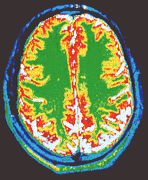 |
Fractals suggest that Los Angeles is behind on its quota of earthquakes
Astronomers have found that galaxies tend to be gathered into clusters, and
that these are themselves arranged into superclusters. In other words,the
entire universe is fractal in nature - its fractal dimension is, apparently,about
1.2.
But fractals are also giving astronomers headaches. Many planets, stars and
galaxies are known to have magnetic fields and for years astronomers thought
they knew why. The rotation of these giant bodies swept up charged particles.
so the theory went, with the swirling motion generating the magnetic field
through a dynamo effect. Now this simple picture is threatened by the discovery
that the loops of electromagnetic energy in galaxies may be fractal - that
is, riddled with ever tinier twists which stop the magnetic field from building
up. If true, astronomers will have to think again about the origin of cosmic
magnetism.
Of all the new applications of fractals, the most surprising comes from Dr
Ed Bullmore and his team at the Institute of Psychiatry in London. They have
been measuring the fractal nature of the human brain - and found links with
depression and schizophrenia.
The idea that the brain's shape may be connected to behaviour is not new.
In the late 18th century, the Austrian physician Franz- Joseph Gall suggested
a link between personality and skull shape. Known as phrenology, his was
a nice idea, spoiled only by the fact that there is no correlation between
the shape of the skull and any feature of the brain.
But the advent of medical scanning has breathed new life into Gall's idea.
Scanning technology has been used to study the outer grey matter and the
inner white matter of the brain. By measuring the fractal dimension
("jaggedness") of this boundary in dozens of patients. the team found that
patients who suffer from manic depression have a more "jagged" grey-white
matter boundary than normal people. In contrast. those with schizophrenia
seemed to have particularly smooth boundaries.
The explanation behind this modern "phrenology" is a mystery, but it may
yet prove useful. If so, it will be another triumph for the mathematical
enigma whose properties were for so long just a toy.
Robert
Matthews |
